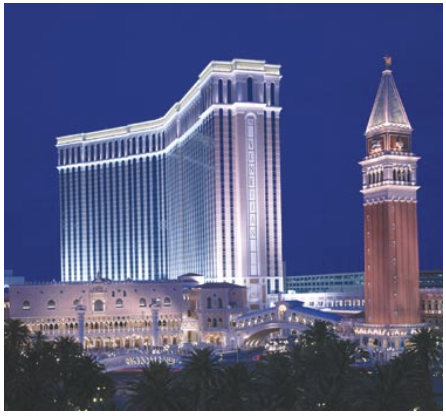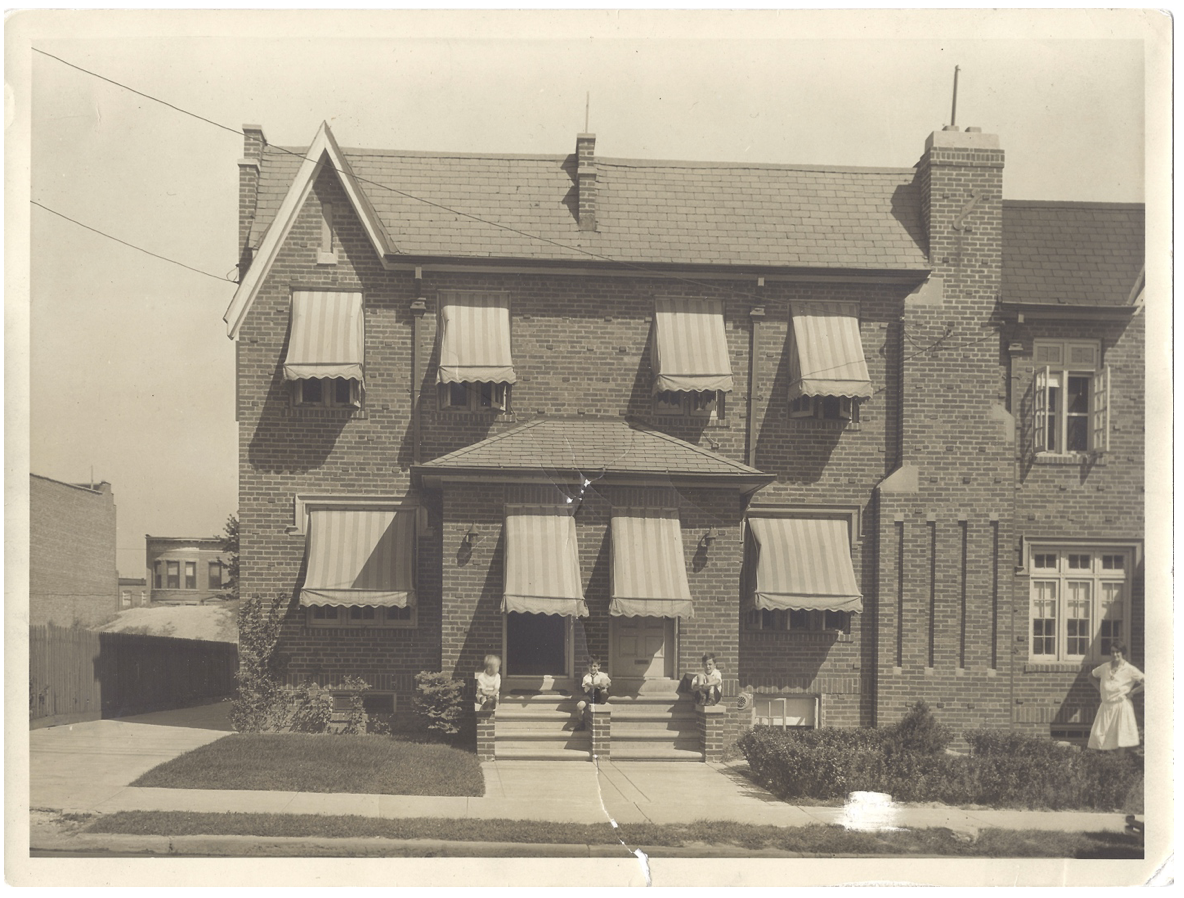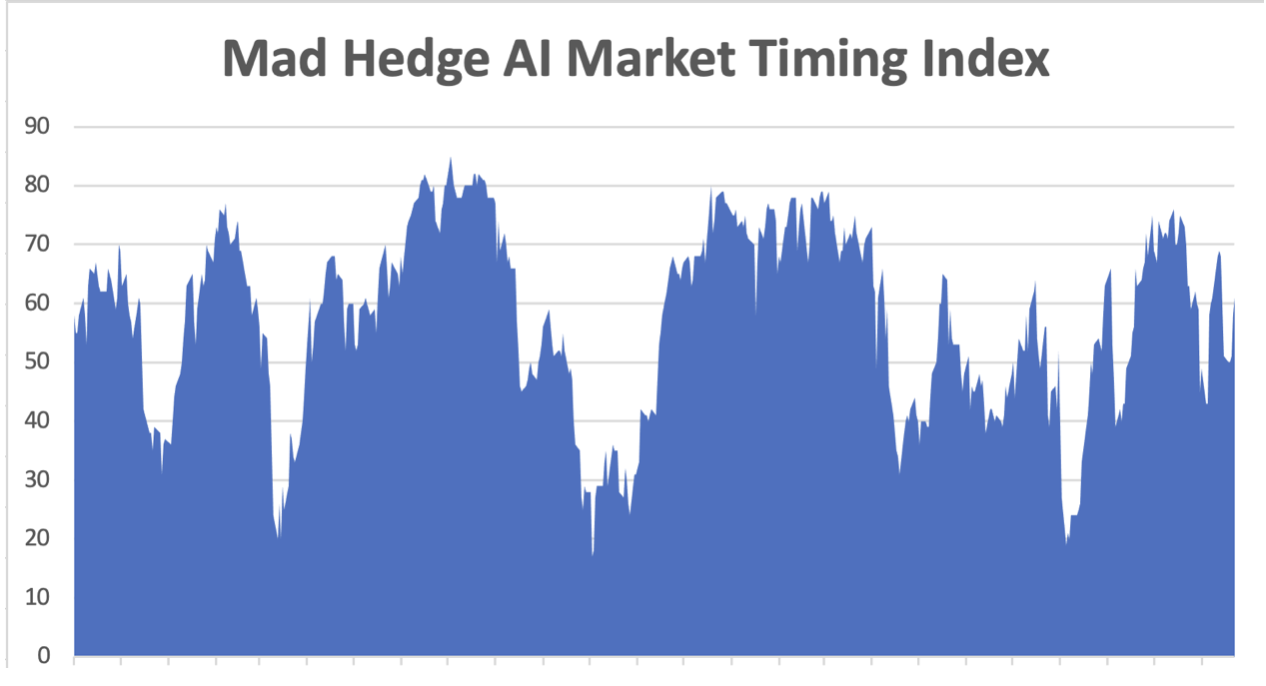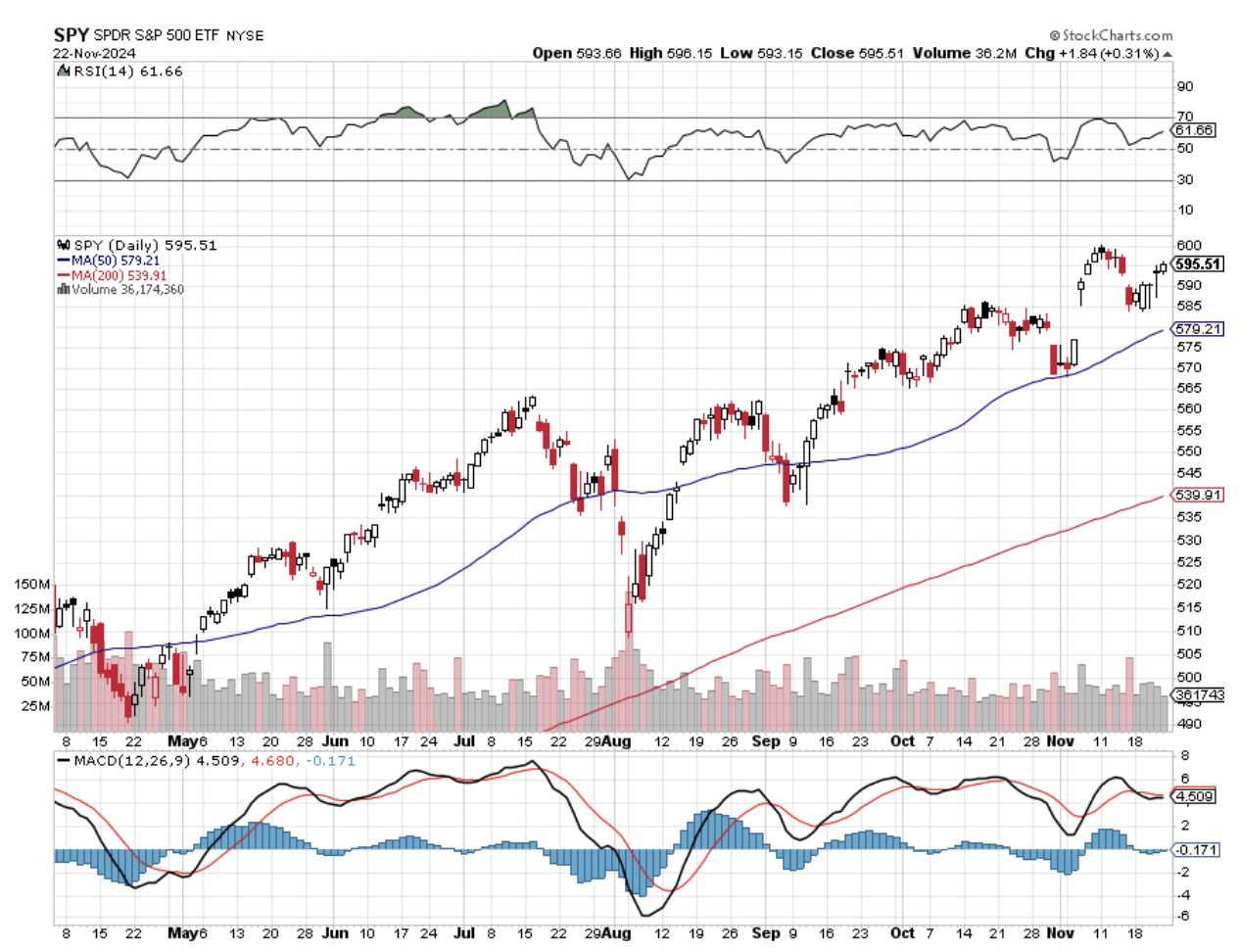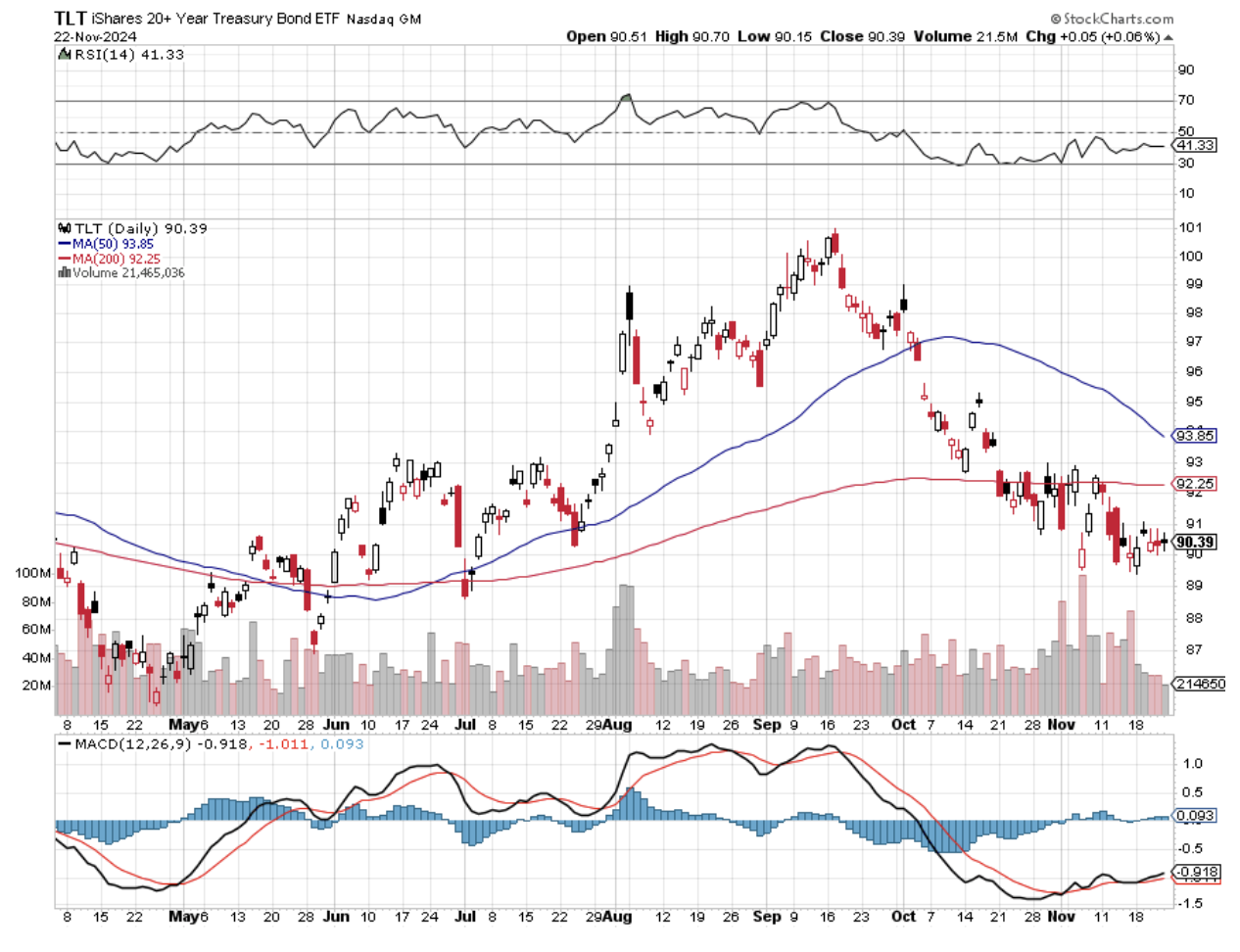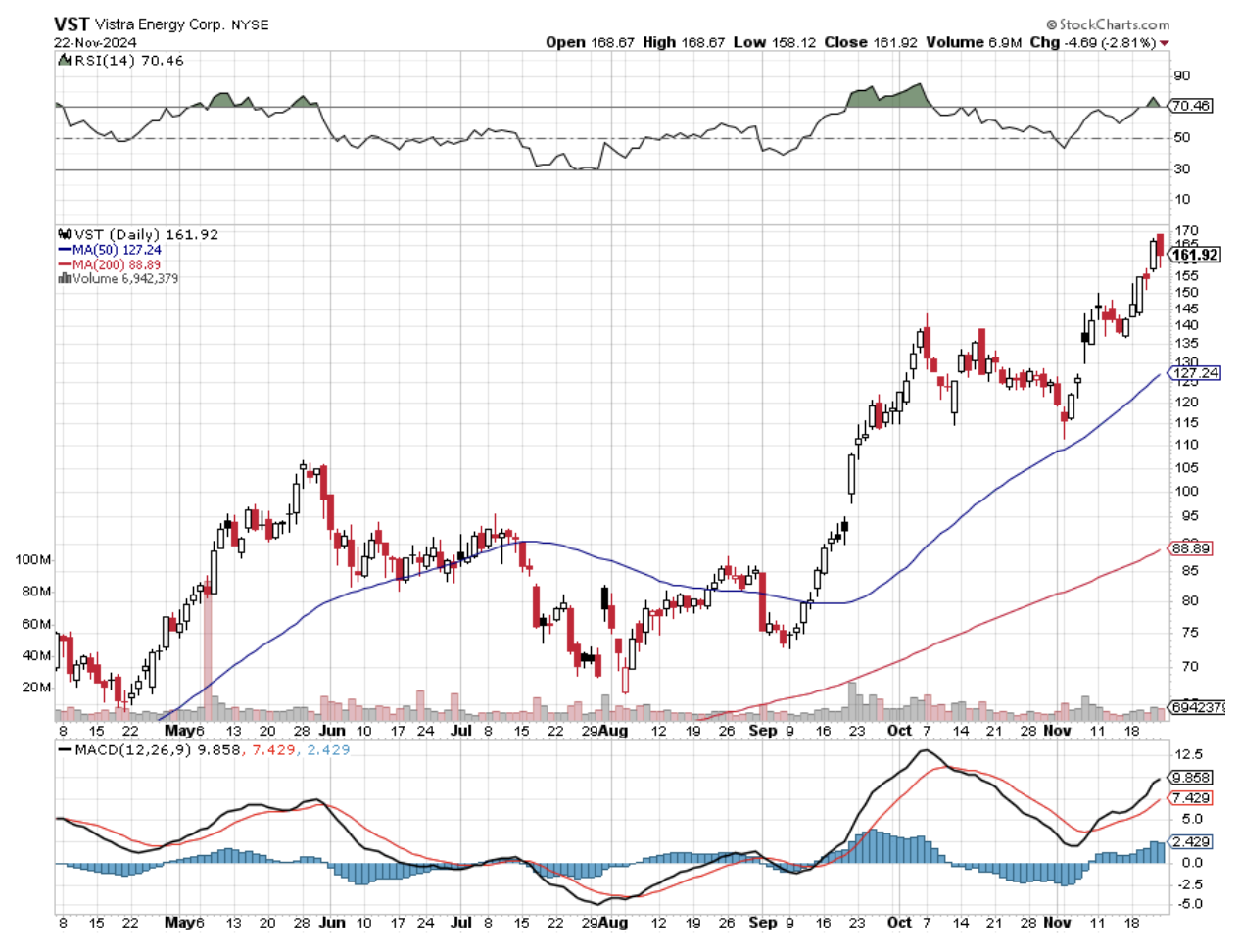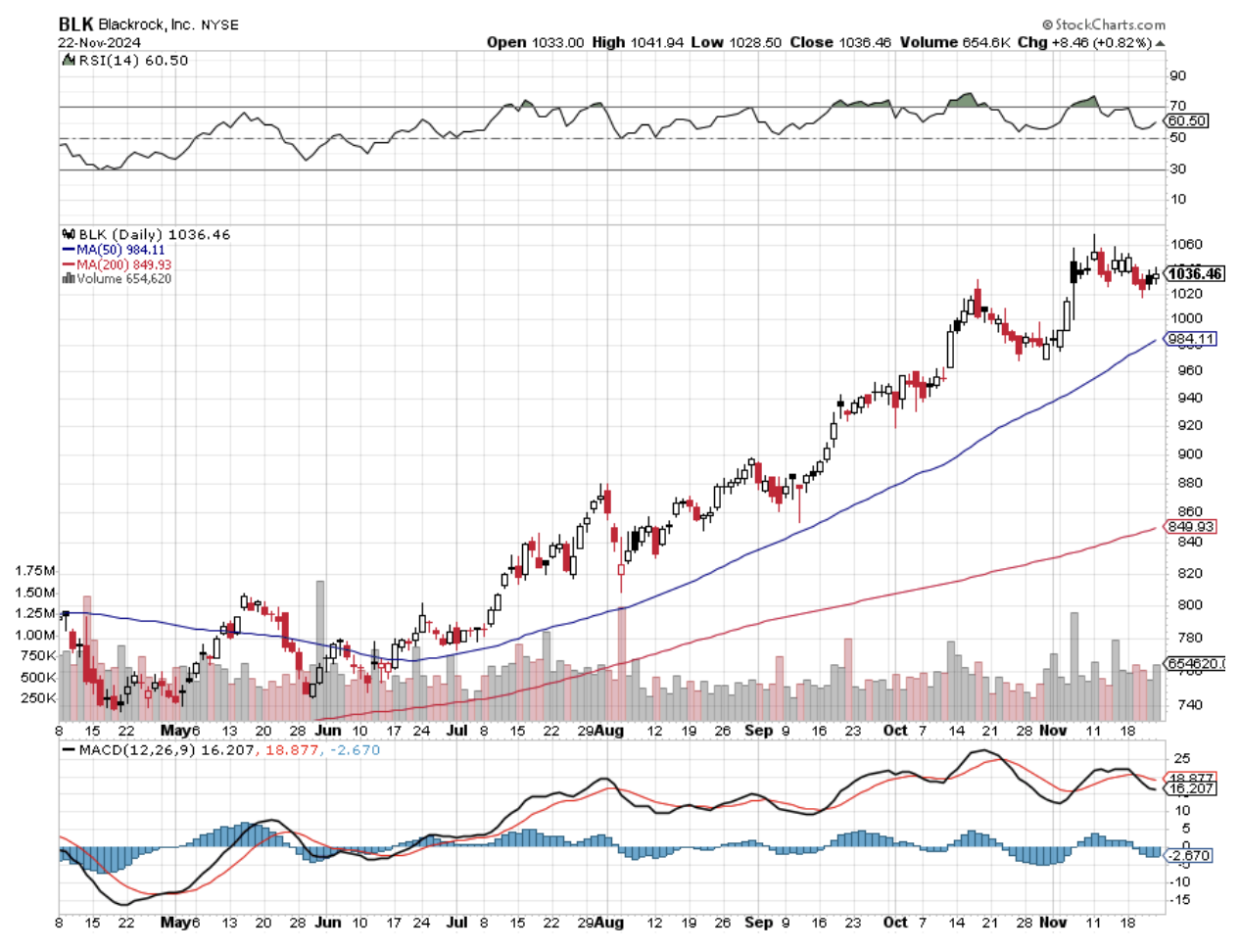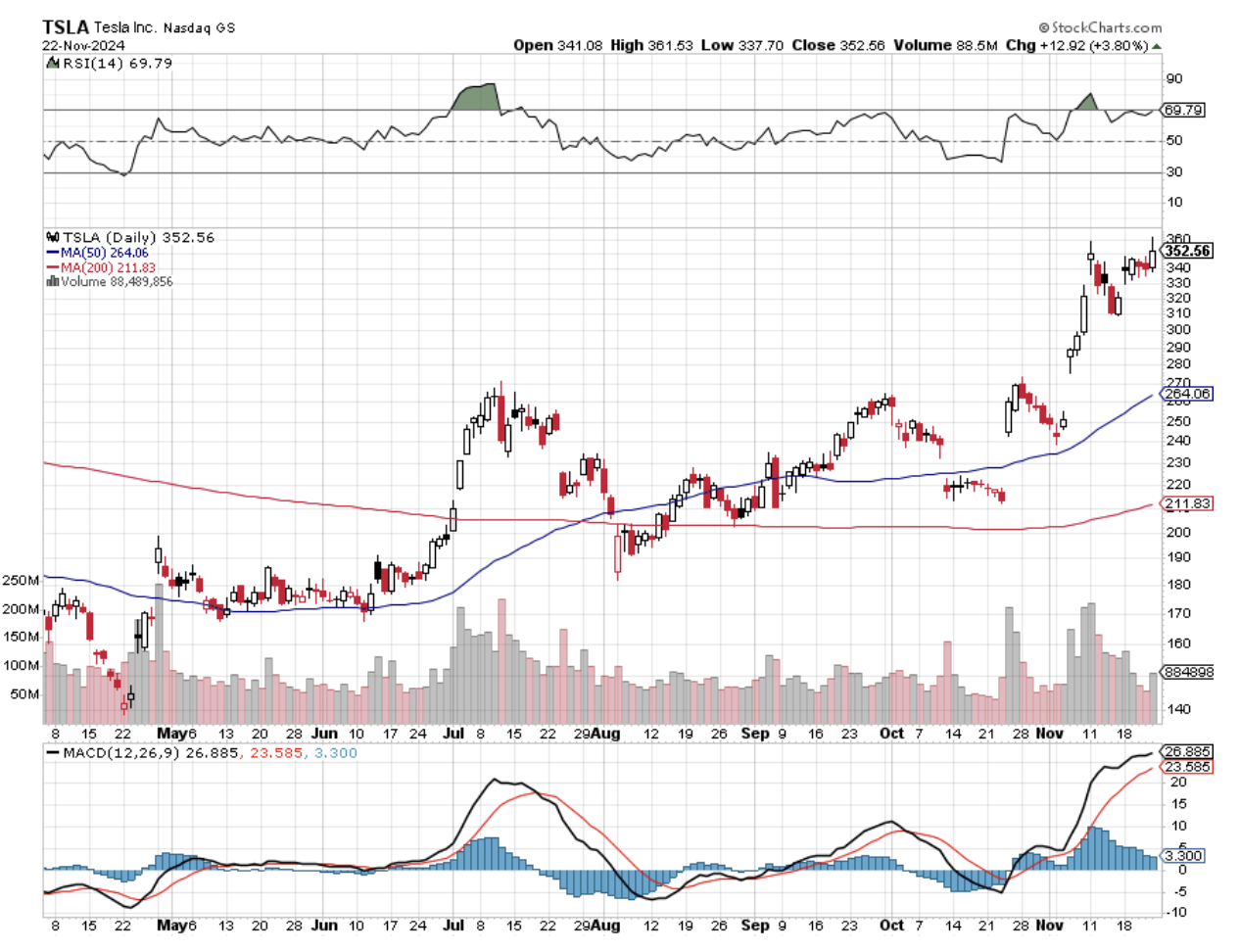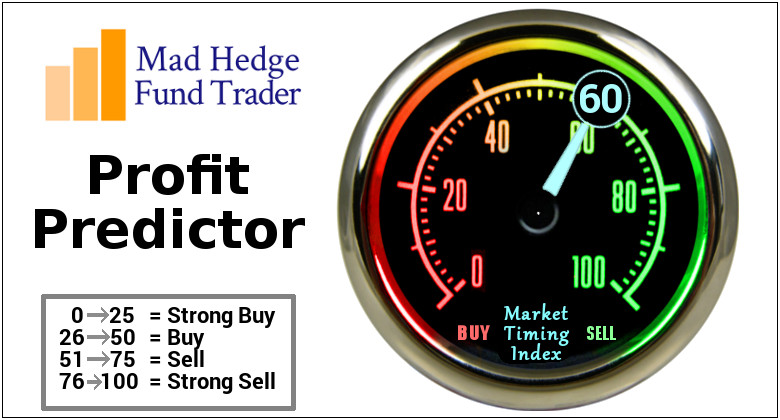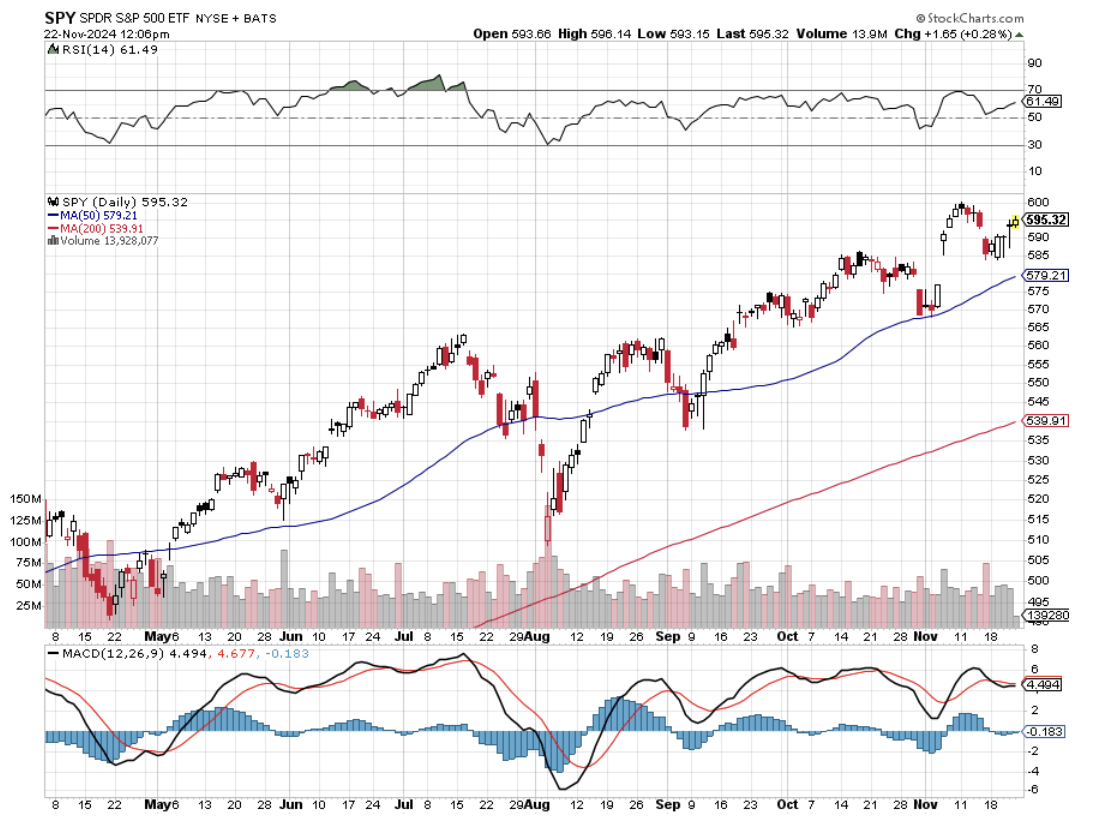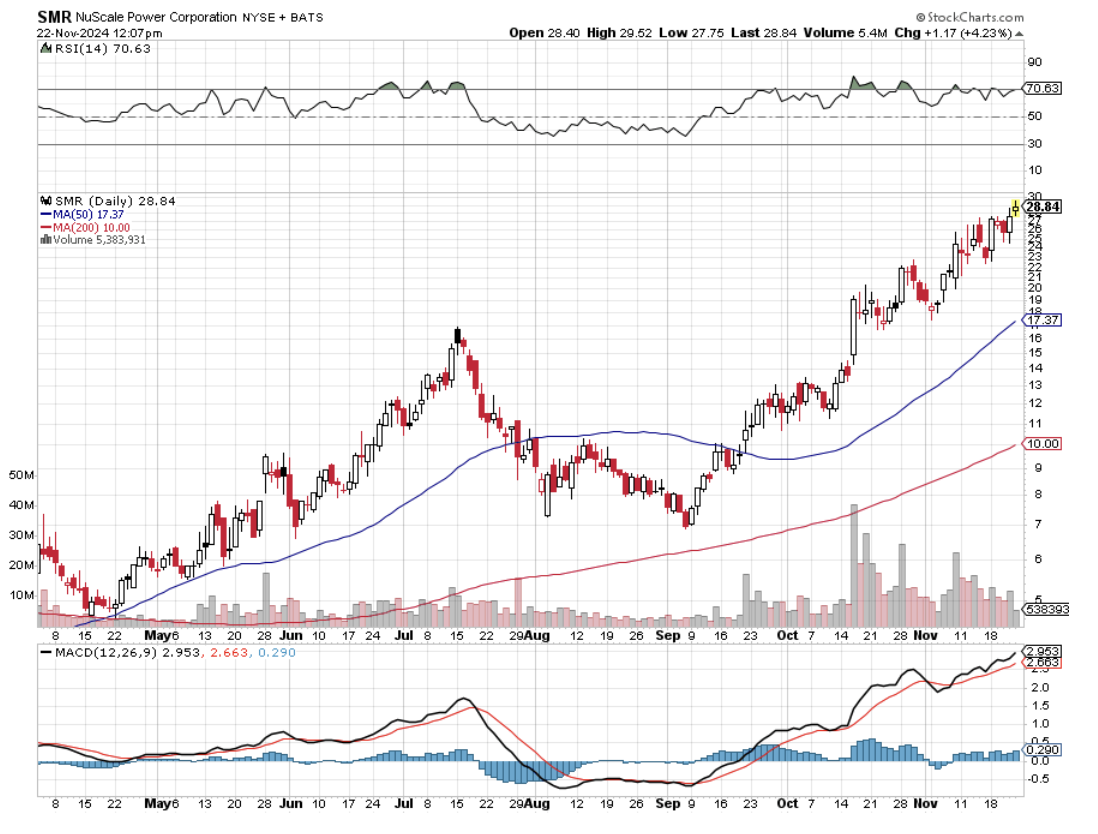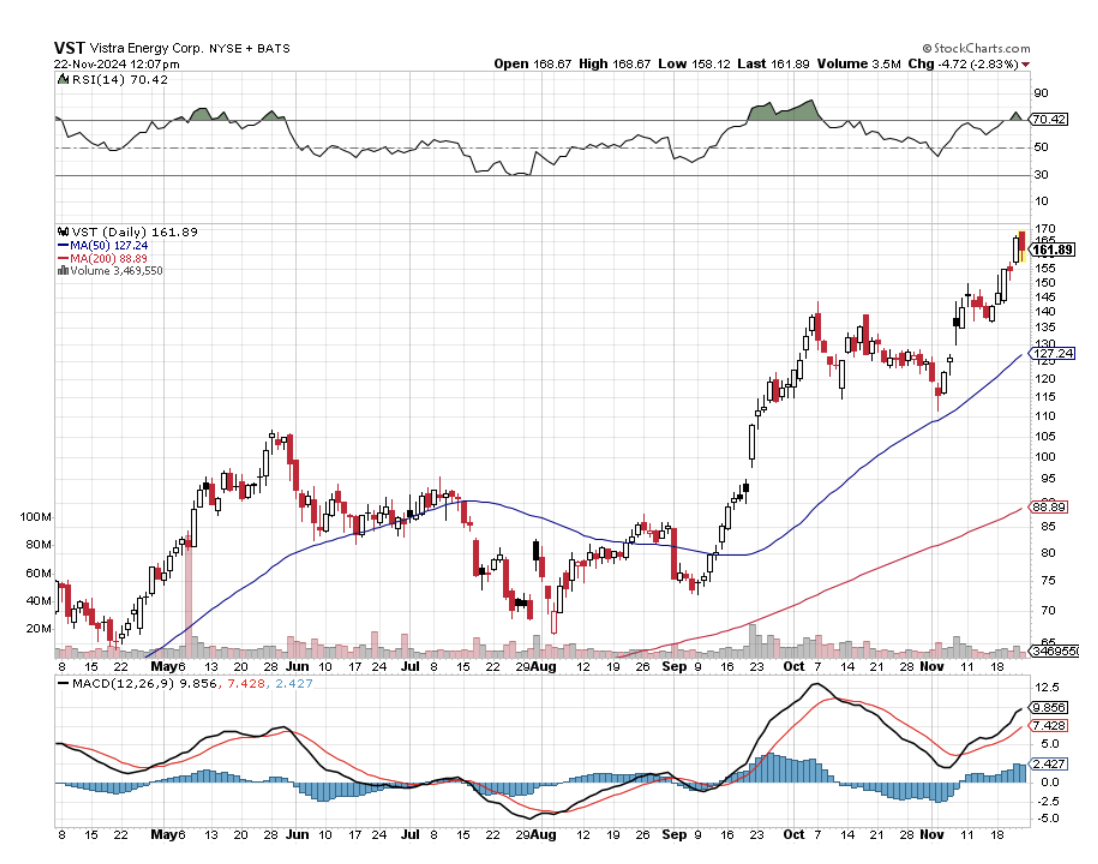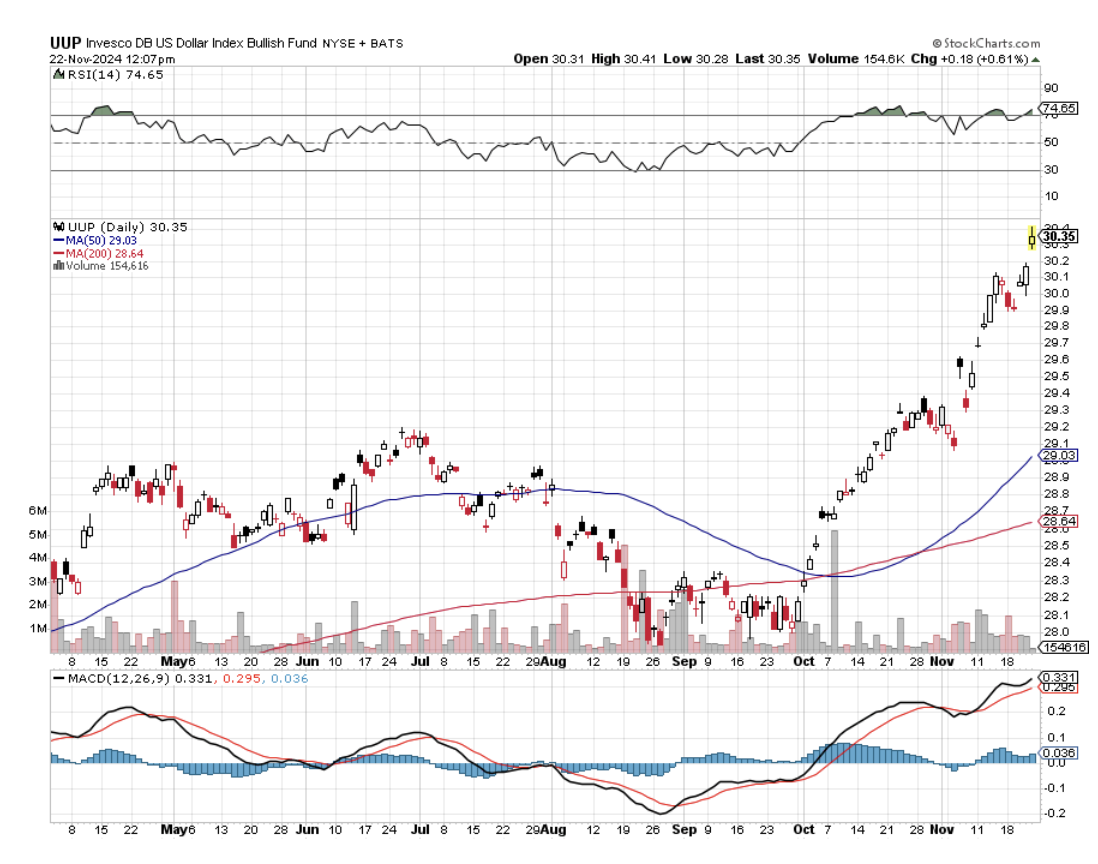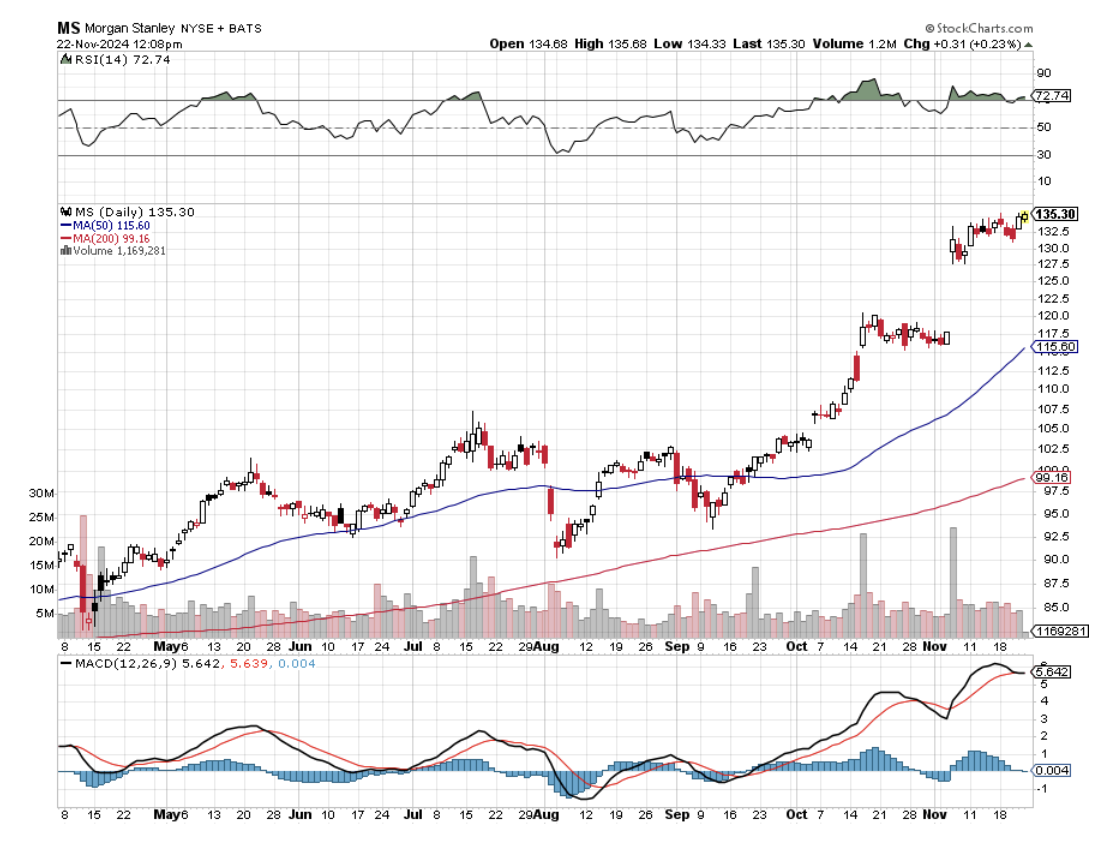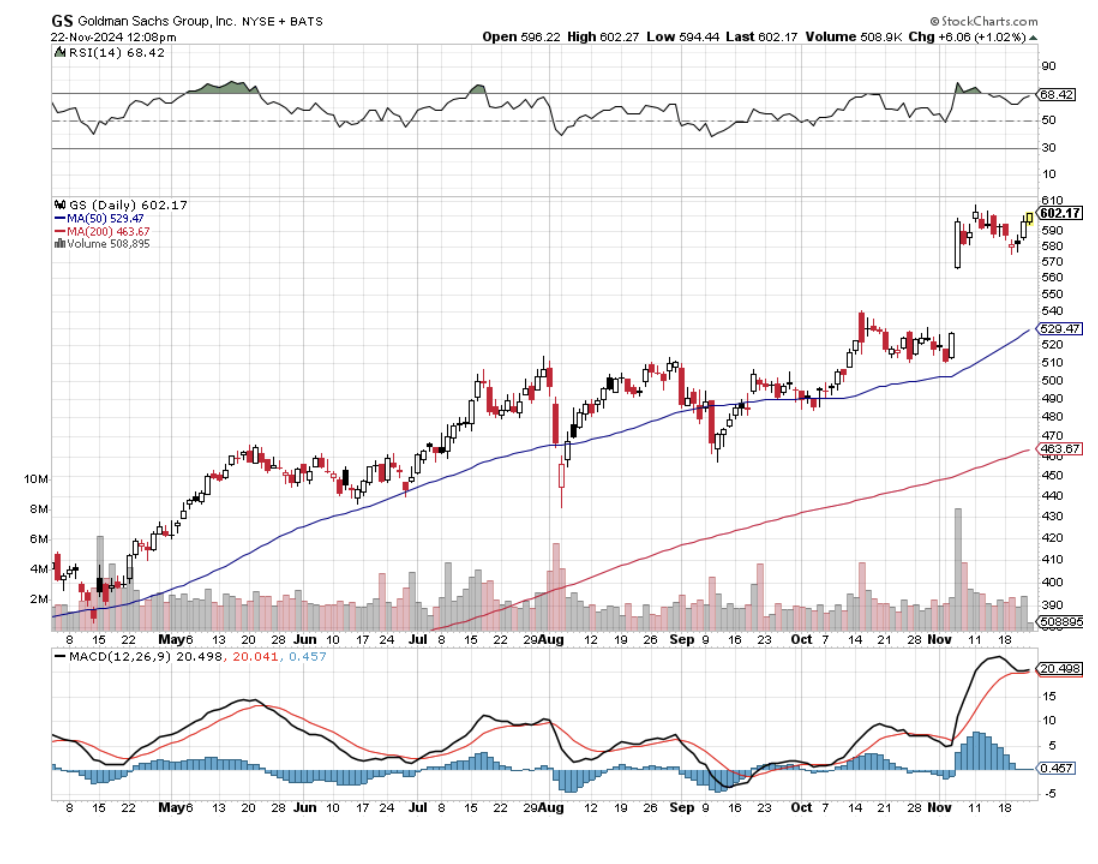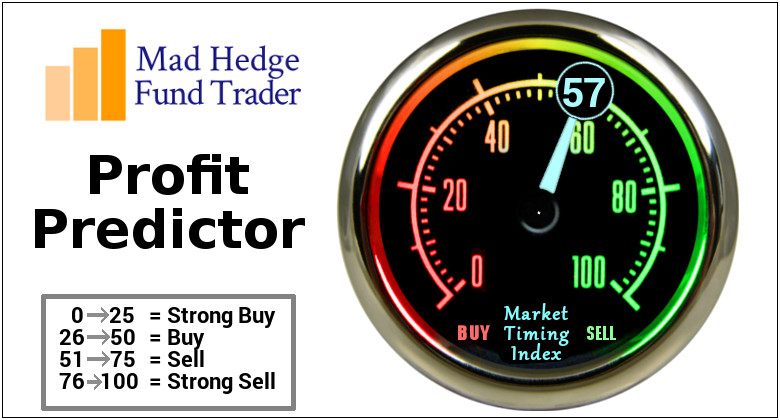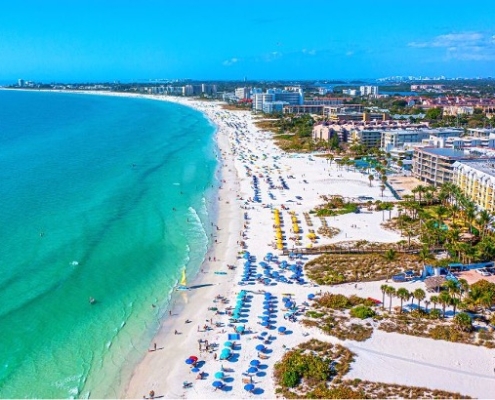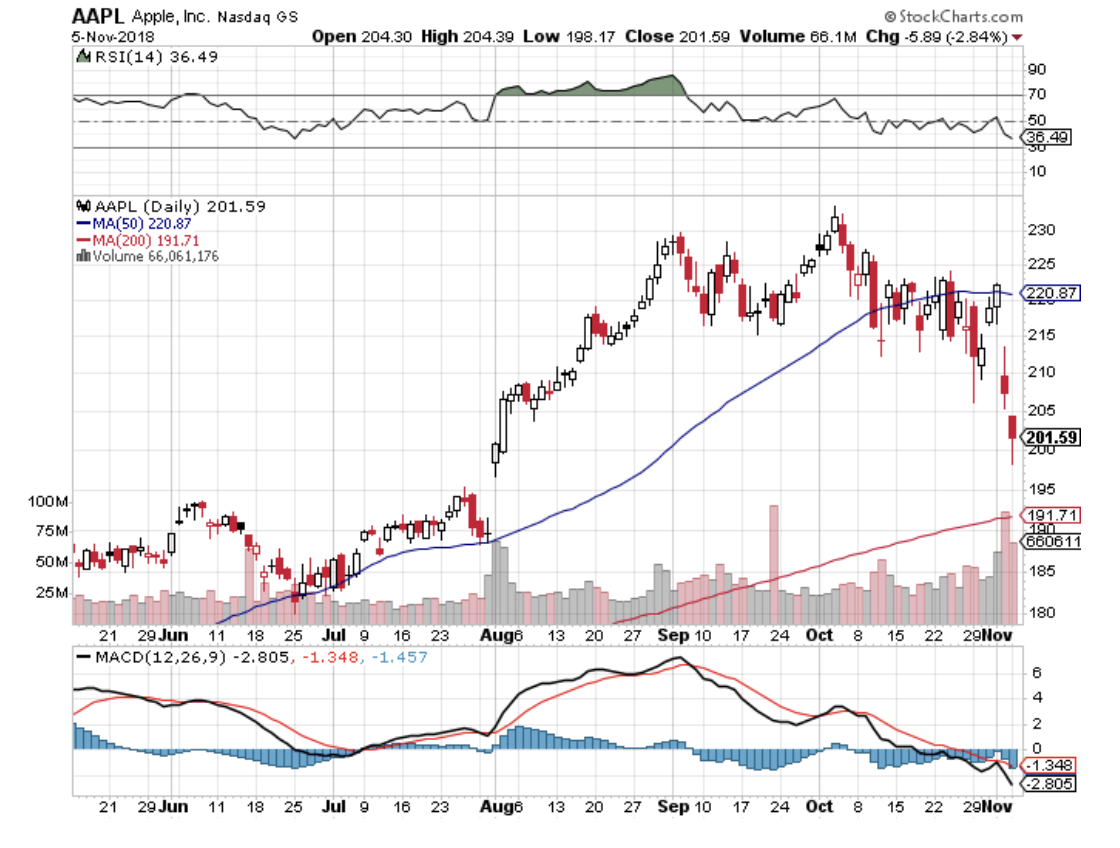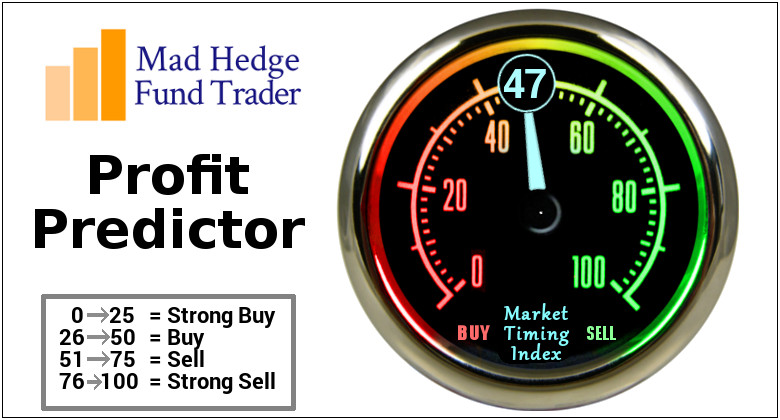
Global Market Comments
November 25, 2024
Fiat Lux
Featured Trade:
(MARKET OUTLOOK FOR THE WEEK AHEAD or WHAT TO DO ABOUT NVIDIA), plus THE WORLD’S WORST INVESTOR),
(NVDA), (GLD), (JPM), (JPM), (NVDA), (BAC), (C),
(CCJ), (MS), (BLK) (TSLA), (TLT)
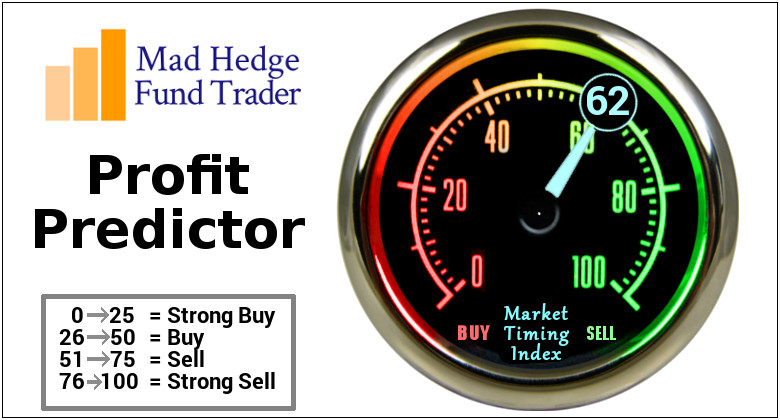
Boy, did I make the right move going into the election?
I always have a propensity to reduce risk going into a major event. Let the newbies stick their necks out. I’ll collect the low-hanging fruit afterward while trampling over their bodies. As they used to say at Morgan Stanley, “It’s the pioneers who get the arrows in their backs.”
So I went into the November 5 election with 70% cash and long JP Morgan (JPM), Nvidia (NVDA), and gold (GLD). On November 6, I quickly stopped out of gold at cost and let the other two run, which launched on major rallies driven by a new deregulation trend. I then converted the remaining cash into a deregulation portfolio.
The bottom line? Since the election, I have been able to run up a monster 18.05% profit in only 14 trading days. That works out to 1.29% a day, the most earned in the nearly 17-year history of the Mad Hedge Fund Trader.
Notice that no specific deregulation measures have been proposed. No action has been taken. What we are seeing in unrestrained buying is driven by beliefs, animal spirits, and unbounded optimism, which markets all love. Call it euphoria. The problem with euphoria is that it fades as easily as it starts. After the 2016 election, the euphoria lasted for four months, then the market died for three months.
We’ve heard a lot about deficit reduction in the coming years, and let me tell you that the bond market isn’t buying it for a second. Since September, Fed Funds futures markets have plunged from 350 basis points in interest rate cuts by June to only 150 basis points, and half of that has already been done. Even the December 25 basis point rate cut has shrunk to only a 50% probability.
And this is what the bond market has been sniffing out. Tax cuts, spending increases, mass deportation of minimum wage workers, and a trade war are all highly inflationary. The voters may buy it, but not bond investors, and the bond market is always right. All it sees is the National Debt rocketing from $35 trillion to $45 trillion in four years.
“Bond market vigilantes” is soon a term you will hear every day.
It's just a matter of time before we get a shocking, out-of-the-blue move-up in a monthly inflation report. That is when the stock market will crash, and bonds get taken out to the woodshed. Next to happen will be a US Treasury auction that fails, spiking interest rates across the board, which recently caused the British government to fall. Then, hello, recession. We will spend the next many months trading against that day. The new administration’s most important appointment will be the guy in charge of borrowing.
And let me tell you about the National Debt, which I learned all about in my years in the White House Press Corp. The Social Security budget now runs at $1.4 trillion a year in payments, while defense is at $825 billion, for a total spend of $2.225 trillion a year. On top of that, you have to add $1 trillion a year in existing interest payments on the outstanding debt.
Even if spending on these two items goes to ZERO, it would take 16 years to pay off the current National Debt. If the debt rises to $45 trillion in four years plus interest, it would take 22.5 years to pay off. And this is with the number of new retirees exploding thanks to the Baby Boomer generation and defense demands in all parts of the world rising by the day.
Cutting the deficit boils down to cutting Social Security, cutting defense, or cutting the tax subsidies for your largest donors (billionaires, the oil industry), which is why it is never going to happen. Any other spending is too small to move the needle.
One of my favorite tests for someone’s knowledge of the federal budget is to ask them how much the US gives away in foreign aid to poor countries every year, a number that gets wildly exaggerated by political parties. The guesses come in at anywhere from 1% to 10% of the total budget. The correct figure? $63.1 billion, or 0.94% of the total $6.7 trillion in US budget expenditures, or less than one-tenth of one percent. You have been warned. I’m going to give you a test the next time I run into you.
The current deficit is, in fact, a product of five successive tax CUTS (Kennedy, Reagan, Bush II, Trump 1, and soon to be Trump II), which now has far and away the lowest income tax rates in the industrialized world. Remember, before Kennedy, the Great Depression maximum marginal tax rate of 90% prevailed.
But you have to get around to know this. I know because I moved an entire hedge fund from London to San Francisco in 1994 to take advantage of lower tax rates and the emerging Internet boom. I saved millions.
Which leads us to the most important question of the day: what to do about Nvidia (NVDA), almost certainly the largest holding of everyone who reads this letter. The company delivered spectacular earnings as promised, but the shares sold off $12. In fact, (NVDA) has only risen by $13 since June, with a drawdown of 37%. Rising volatility with incremental gains is a sign that a stock is topping out. At a $3.6 trillion market capitalization, the spectacular share price gains of the past are no longer attainable. The Law of Large Numbers is kicking in.
I still believe that (NVDA) will rise next year, but not by 200%. Some 20% is more likely. Fortunately, there is something you can do about it. With an options implied volatility of 40%, you can sell short the December 20, 2024, $156 call options against your existing position for $2.20. If Nvidia rises above $156 and your stock gets called away, your net proceeds will be $158.20, and you will think you died and went to Heaven.
If it doesn’t rise above $156, sell the January call options, and you take in another $2.20. After several months, this starts to add up to a lot of money. Eventually, the implied volatility will fade, and this trade won’t be there anymore.
But it works now.
That’s what I would do.
In November, we have gained a breathtaking +17.38%, November is proving to be our largest month of the year. My 2024 year-to-date performance is at an amazing +70.42%. The S&P 500 (SPY) is up +24.73% so far in 2024. My trailing one-year return reached a nosebleed +71.07%, up an incredible $10 on the week. That brings my 16-year total return to +747.05%. My average annualized return has recovered to an incredible +53.68%.
I maintained a 100% long-invested portfolio, betting that the market doesn’t drop below pre-election levels. That includes (JPM), (NVDA), (BAC), (C), (CCJ), (MS), (BLK) and a triple long in (TSLA). My November position in (JPM) expired at max profit. We are now so far in the money with all of our positions we should make 27 basis points a day until the December 20 option expiration in 18 trading days, thanks to time decay and falling volatility.
Some 63 of my 70 round trips, or 90%, were profitable in 2023. Some 74 of 94 trades have been profitable so far in 2024, and several of those losses were really break-even. That is a success rate of +78.72%.
Try beating that anywhere.
My Ten-Year View – A Reassessment
We have to substantially downsize our expectations of equity returns in view of the election outcome. My new American Golden Age, or the next Roaring Twenties, is now looking at a headwind. The economy will completely stop decarbonizing. Technology innovation will slow. Trade wars will exact a high price. Inflation will return. The Dow Average will rise by 600% to 240,000 or more in the coming decade. The new America will be far more efficient and profitable than the old.
My Dow 240,000 target has been pushed back to 2035.
On Monday, November 25 at 8:30 AM EST, the Dallas Fed Manufacturing Index is out.
On Tuesday, November 26 at 8:30 AM, the S&P Case Shiller National Home Price Index is published. At 11:00 AM, the Minutes from the last Fed Meeting are announced.
On Wednesday, November 27, at 8:30 AM, the Core PCE Price Index is 11:00 AM EST. It is a half day for the stock market, which closes at 1:00 PM EST.
On Thursday, November 28, is a National holiday in the US for Thanksgiving.
On Friday, November 29, is Black Friday, and it is a half day for the stock market, which closes at 1:00 PM. At 2:00 PM, the Baker Hughes Rig Count is printed.
Today, I thought I’d recall The World’s Worst Investor, who so happened to be my grandfather on my father’s side.
He was an immigrant from Sicily who joined the army during WWI to attain US citizenship lost an eye when he was mustard gassed on the Western Front in France. I recently obtained his military records from the Department of Defense and learned he was court-martialed for refusing to wash pots and pans at the front while blind!
After the war, the sight came back in one of Grandpa’s eyes, so he
bought a three-bedroom brick home on 76th Street in the Bay Ridge section of Brooklyn street for $3,000, eventually raising four kids. Back then, there was a dairy farm across the street, and horse-drawn wagons delivered ice blocks door to door.
During the roaring twenties, an assortment of relatives chided him for avoiding the stock boom where easy fortunes were made trading on ten to one margin. When the 1929 crash came, all of them lost their homes. Grandpa finished off the basement, creating space for two entire families to move in. He had never bought a stock in his entire life.
Because Dad contracted malaria with the Marines on Guadalcanal during WWII, the old man moved the family to Los Angeles in 1947 for the dry, sunny weather. Unfortunately, my grandmother heard there were no lobsters on the west coast, so she packed two big Maine ones in a suitcase. By the time they got to Las Vegas, the smell was so bad they got kicked off the train. In the booming postwar economy, they had to wait a week to get new seats to LA.
That was enough time for a flimflam man to sell Grandpa five acres of worthless land for $500. Ten years later, my dad drove out to check out the investment. It was a tumbleweed-blown, jackrabbit and rattlesnake-ridden piece of land so far out of town that it had to be worthless. You couldn’t see downtown, even if you stood on the rusted-out model “T” Ford that occupied the site. After that, the parcel became the family joke, and Grandpa was ridiculed as the world’s worst investor.
Grandpa died of cancer in 1977 at the age of 78. What German shrapnel and gas failed to accomplish, 60 years of smoking two packs a day of non-filter Lucky Strikes did. The army gave him cigarettes for free during the war, and he never shook the addiction. Even at the end, he insisted that there was no “proof” that cigarettes caused cancer, which soldiers referred to as “coffin nails.”
His estate executor put the long-despised plot out of Sin City up for sale, and a bidding war ensued. Although the final price was never disclosed, it was thought to be well into eight figures. In the intervening 30 years, the city of Las Vegas had marched steadily westward towards Los Angeles, sending its value through the roof. The deal triggered a big fight among the heirs, those claiming he was the stupidest demanding the greatest share of the proceeds, the bad blood generated continuing to this day. It turns out the world’s worst investor was actually the best, we just didn’t know it.
What was the address of this fabled piece of real estate? Why, it is 3325 Las Vegas Blvd. South, the site today of the Venetian and Palazzo Hotels, home to the Dal Toro restaurant, the venue for the last Mad Hedge Fund Trader’s Las Vegas strategy luncheon.
I’m sure Grandpa is laughing in his grave, in between smoles.
Bought for $500 in 1947
Postscript. One day in New York a few years ago, I had a few hours to spare waiting to board Cunard’s QEII to sail for Southampton, England.
So, I decided to check out the Bay Ridge address that I had heard so much about during my childhood. I took a limo over to Brooklyn and knocked on the front door. I was told the owner was expecting a plumber, so he let me straight in, not noticing my Brioni blue blazer nor the Cadillac stretch limo out front.
I told him about my family history with the property, but I could see from the expression on his face that he didn’t believe a single word.
Then, I told him about the relatives moving into the basement during the Great Depression. He immediately let me in and gave me a tour of the house. He told me that he had just purchased the home and had extensively refurbished it. When they tore out the walls in the basement, he discovered that the insulation was composed of crumpled-up newspapers from the 1930s, so he knew I was telling the truth.
I told him that Grandpa would be glad that the house was still in Italian hands. Could I enquire what he had paid for the house that sold in 1923 for $3,000? He said he bought it as a broken-down fixer-upper for a mere $775,000. And this was after the housing crash in 2011.
My Grandparents 1926
The Fabled Bay Ridge House Bought for $3,000
Good Luck and Good Trading,
John Thomas
CEO & Publisher
The Diary of a Mad Hedge Fund Trader
“Wars are easier to get into than to get out of,” said former Secretary of Defense, Robert M. Gates.
Global Market Comments
November 22, 2024
Fiat Lux
Featured Trade:
(WEDNESDAY, JANUARY 22, 2025 ST AUGUSTINE FLORIDA STRATEGY LUNCHEON)
(NOVEMBER 20 BIWEEKLY STRATEGY WEBINAR Q&A),
(NVDA), (TSLA), (TLT), (OXY), (SLB), (MSTR), (USO), (PLTR), (SMCI), (KRE), (SMR), (UUP)
Below, please find subscribers’ Q&A for the November 20 Mad Hedge Fund Trader Global Strategy Webinar, broadcast from Lake Tahoe, Nevada.
Q: What are your stock recommendations for the end of the first quarter of 2025?
A: I say run with the winners. Dance with the girl who brought you to the dance. I think portfolio managers are going to be under tremendous pressure to buy winners and sell losers. And, of course, you all know the winners—they’re the stocks I have been recommending all year, like Nvidia (NVDA), Tesla (TSLA), and so on. And they're going to sell losers like energy to create the tax losses to offset their gains in the technology area. That could continue well into next year. Although, we’ve probably never entered a new administration with more uncertainty at any time in history, except maybe during the Civil War. I don’t think it will get as bad as that, but it could be bad.
Q: Is Putin bluffing about nuclear war?
A: Yes. First of all, Russia has 7,000 nuclear weapons, but only maybe 200 of those work. If he does use nuclear weapons, Ukraine will use its nuclear weapons in retaliation. During the Soviet Union, where did the Soviet Union make all their nuclear weapons? In Ukraine. That's where they had the scientists. They certainly have the Uranium—that's the hard part. You could literally put one together in days if you had the right expertise around. This will never go nuclear, and Putin has always been all about bluffing. There's a reason why the world's greatest chess masters are all Russian; it's all about the art of bluffing. So that doesn't worry me at all.
Q: Will Russia sacrifice a higher and higher percentage of its population in the war?
A: Yes, that is the military strategy: keep throwing bodies at your enemy until they run out of bullets.
Q: What is your prediction for 30-year US Treasury yields (TLT)?
A: They go higher. Higher for longer certainly includes the 30-year. The 30-year will be the most sensitive to long-term views of interest rates. If you get a return of inflation, which many people are predicting, the 30-year gets absolutely slaughtered. Adding a potential $10 trillion to the national debt, taking it to $45 trillion, is terrible for debt instruments everywhere.
Q: Should we be exiting the LEAPS that you put out on Occidental Petroleum (OXY) and Schlumberger (SLB)?
A: For Occidental, I would say maybe; it’s already at a low. The outlook for oil prices is poor, with massive new production coming on stream. Regarding Schlumberger, they make their money on the volume of oil production—that probably is going to be a big winner.
Q: What do you think interest rates will do as we go into the end of Powell's term in 18 months?
I have no idea. It just depends on how fast inflation returns. My guess is that we'll get an out-of-the-blue sharp uptick in inflation in the next couple of months, and when that happens, stocks will get slaughtered. People assume that inflation just keeps going up forever after that.
Q: Crude oil (USO) has been choppy at around $70 a barrel. Where do you see it going next year?
A: My immediate target is $60, and possibly lower than that. It just depends on how fast deregulation brings on new oil supplies, especially from the federal lands that have been promised to be opened up. As it turns out, the federal government owns most of the western United States—all the national forests and so on. If you open that up to drilling, it could bring huge supplies onto the market. That would be deflationary. It would be death for oil companies, but it would be a death for OPEC as well. Every cloud has a silver lining. OPEC has been a thorn in my side for the last 60 years.
Q: I'm tempted to buy stocks that are flying up, like Palantir (PLTR) and MicroStrategy (MSTR). What would be an experienced investor trade in these situations?
A: Don't touch them with a 10-foot pole. You buy stocks before they fly up, not afterwards. By the way, if anyone knows of an attorney who is an expert at recovering stolen Crypto, please contact me. I have several clients who've had their crypto accounts cleaned out. Oh, and by the way, the heads of every major crypto exchange have been put in jail in the last three years. Imagine if the heads of Goldman Sachs, Morgan Stanley Fidelity, and Vanguard were all put in jail for fraud and theft? How many stocks would you want to buy after that? Not a lot.
Q: Your recommendations for AI and chips?
A: I think you get a slowdown. In order to buy the new plays in banks, brokers, and money managers, you need to sell the old plays. Those are going to be technology stocks and AI stocks—AI itself will keep winning. They will keep advancing, but the stocks have become extremely expensive. And everyone is waiting to see how anti-technology the new administration will be. Some of the early appointments have been extremely anti-technology, promising to rein in big tech companies. If you rein in big tech companies, you rein in their stock prices, too. I am being very cautious here. The next spike up in Nvidia (NVDA) might be the one you want to sell.
Q: Do you think the uranium play will continue under the new administration?
A: Absolutely, yes. Restrain the Nuclear Regulatory Commission, and costs for the new nuclear starts up like (SMR) go way down.
Q: What do you think of NuScale Power Corp (SMR)?
A: I love it. Again, deregulation is the name of the game—and if you lose a city by accident, tough luck. Let's just hope it happens somewhere else. It's only happened three times before… Three Mile Island, Chernobyl, and Fukushima.
Q: Super Micro Computer (SMCI), what do you think?
A: Don't touch it. There's never just one cockroach. Hiring a new auditor to find out how much money they misrepresented is not a great buy argument to buy the stock. I'm sorry. Very high risk if you get involved.
Q: If Nvidia (NVDA) announces great earnings but sells off anyway, what should I do?
A: Get rid of it and get rid of all your other technology stocks because this is the bellwether for all technology. Tech always comes back over the long term, but short term, they may continue going nowhere as they have done for the last six months, which correctly anticipated a Trump win. Trump is not a technology guy— he hates California. Any California-based company can't expect any favors except for Tesla.
Q: Is there any reason why you prefer in-the-money bull call spreads?
A: Well, there are lots of reasons. Number 1, it's a short volatility play. Number 2 it's a time decay play, which is why I only do front months because that's when the time decay is accelerated. Thirdly, it allows you to increase your exposure to the stock by tenfold, which brings in a much bigger profit when you're right. If you look at our trade alerts, we make 15% to 20% on every trade, and 200 trades a year adds up to a lot of money. You can see that with our 75% return for this year. And it's a great risk management tool; the day-to-day volatility of call spreads is low because you're long one call option short the other. So, the usual day-to-day implied volatility on the combination is only about 8% or 9%. The biggest problem with retail investors is the volatility scares them out of the market at market lows and scares them back in at market highs. So, call spread reduces the volatility and keeps people from doing that. The risk-reward is overwhelmingly in your favor if you have somebody like me with an 80% or 90% success rate making the calls on the stocks. And, of course, having done this for almost 60 years, nothing new ever happens in the stock market—you're just getting repetitions of old stuff. All I have to do is figure out is this the 1970s story, the 1980s story, the 1990s, the 2000s, 2010s story? I have to figure out which pattern is being repeated. People who have been in the market for one year, or even 10 years, don't have that luxury.
Q: I’m having trouble getting filled on your orders.
A: You put out a spread of orders. So if I put in an order to buy at $9.00, split your order up into five pieces: at $9.00, $9.10, $9.20, $9.30, $9.40; and one or all of those orders will get filled. Another hint is that algorithms often take my trade alerts to the maximum price. Don't pay more than that price immediately, but they have to be out by the end of the day, so if you just enter good-till-cancel orders, you have an excellent chance of getting filled by the end of the day or at the opening tomorrow.
Q: Should I purchase SPDR S&P Regional Banking ETF (KRE)?
A: I'd say yes. That probably is a good buy with deregulation, making all of these small banks takeover targets.
Q: What should we be looking for in the fear and greed index?
A: When we get to the high end, like in the 70s, start taking profits. When we get to the low end, like the 20s, start buying and adding LEAPS and more long-term leverage option plays.
Q: What are we looking for to go short?
A: Much higher highs and a bunch of other monetary and technical indicators flashing warning signals, which are too many to go into here. Suffice to say, we did make good money on the short side this year, a couple of times on Tesla (TSLA), including a pre-election short that we covered in Tesla, and we were short a whole bunch of technology stocks going into the July meltdown. So, you know, we do both the long side and the short side, but it's been a long play—11 months this year and a short play for a month.
Q: Is the euro going back up eventually, or does the dollar (UUP) rule?
A: Sorry, but as long as the US dollar has the highest interest rates in the developing world and the prospect of even higher rates in the future, it's going to be a dollar game for the next couple of years.
Q: Will a ceasefire in the Middle East affect the markets?
A: No. The U.S. interest in geopolitical data ends at the shores—all three of them. So if the war of the last couple of years doesn't change the market—and it's been an absolutely horrific war with enormous civilian casualties—why should the end of it affect markets?
Q: What stock market returns do you see for the next four years?
A: About half of what they were for the last four years, which will be about 90% by the time Biden leaves office. You're going to have much higher interest rates and much higher inflation, and while the new administration is very friendly for some industries, it is very hostile for others, and the net could be zero. So, enjoy the euphoria rally while it lasts.
Q: What about crypto?
A: Well, I did buy some crypto for myself at $6,000, and I'm now thinking of selling it at $96,000. Would I recommend it to a customer? Not on pain of death—not at this level. You missed the move. Wait for the next 95% decline, which is a certainty in the future. And, by the way, absolutely nobody in the industry can tell you when that is.
To watch a replay of this webinar with all the charts, bells, whistles, and classic rock music, just log in to www.madhedgefundtrader.com, go to MY ACCOUNT, select your subscription (GLOBAL TRADING DISPATCH, TECHNOLOGY LETTER, or Jacquie's Post), then click on WEBINARS, and all the webinars from the last 12 years are there in all their glory
Good Luck and Good Trading
John Thomas
CEO & Publisher
The Diary of a Mad Hedge Fund Trader
Global Market Comments
November 21, 2024
Fiat Lux
Featured Trade:
(THURSDAY, JANUARY 16, 2025 SARASOTA FLORIDA STRATEGY LUNCHEON)
(TEN REASONS WHY I ONLY EXECUTE VERTICAL CALL DEBIT SPREADS)
(AAPL), ($VIX), (SPY)
Come join me for lunch at the Mad Hedge Fund Trader’s Global Strategy Luncheon, which I will be conducting in Sarasota, Florida on Thursday, January 16, 2025. The cost of the luncheon will be $277.
An excellent meal will be followed by a wide-ranging discussion and an extended question and answer period.
I’ll be arriving early and leaving late in case anyone wants to have a one-on-one discussion, or just sit around and chew the fat about the financial markets.
The lunch will be held at an exclusive Sarasota hotel. The precise location will be emailed with your purchase confirmation. Mad Hedge guests will be assigned their own dedicated table in a ballroom with 200 other participants.
I look forward to meeting you, and thank you for supporting my research.
To purchase tickets for this luncheon, please click here.
At today’s Mad Hedge Biweekly Strategy Webinar, I received an excellent question: Why is the Vertical Call Debit Spread my favorite trading vehicle?
So let me ask you this: How would you like to play blackjack now that the dealer would bust 90% of the time? What if you played roulette with the assurance that the ball would land on black 90% of the time?
I bet you would be interested….very interested.
I only trade with Vertical Call Debit Spreads in my own personal account. While your broker may be recommend outright options trades to you because that’s where the volume and the commissions are, if he is smart enough, he is almost certainly executing Vertical Call Debit Spreads for his own account.
And let me tell you why.
1) A Vertical Call Debit Spread offers the most favorable risk/reward ratio of any financial instrument among the plethora out there.
2) A Vertical Call Debit Spread allows you to precisely define your risk. You can’t lose any more money that you put up. With naked short puts, for example, which most other newsletters often recommend all day long, your potential losses are unlimited
3) Vertical Call Debit Spreads allow a vast increase in profits compared to outright stocks, potentially 10X-100X. You can get a claim on $1 million worth of stock for literally only $10,000, not bad when you know the direction. Customers of mine who are nailing 1,000%-2,000% returns in a year, and I get a few every year, are executing very deep out-of-the-money Vertical Call Debit Spread LEAPS.
4) The liquidity for Vertical Call Debit Spreads is enormous for the most popular stocks, like Nvidia (NVDA) and Tesla (TSLA), with exercise values of the options more than the underlying stocks.
5) Vertical Call Debit Spreads allow you to specifically target a share price trading range (very deep in-the-money) that has the highest probability of taking place.
6) The day-to-day volatility of Vertical Call Debit Spread is very low, usually 8% or 9%. That’s because you are long on one option and short on another. This prevents traders from selling bottoms and buying tops, always fatal mistakes. When people ask me what I do for a living, I tell them I stop people from selling market bottoms and buying market tops.
7) When you have a seasoned war horse like me with 55 years of trading experience making your stock picks, Vertical Call Debit Spreads become a total no-brainer. This is why my Trade Alert service is up 68% this year, almost triple the S&P 500 (SPY).
8) Vertical Call Debit Spreads hit their maximum profit whether markets go up, sideways, or down small. It’s only the surprise out of the blue, down moves are large, triggered by black swans, that lose us money and those we stop out of immediately.
9) A Vertical Call Debit Spread benefits enormously from time decay. That is how they hit maximum profits when the underlying stock is unchanged. It gives you a cushion against mistakes and bad stock calls. That’s why I focus on the front-month expirations where time decay is accelerated.
10) Vertical Call Debit Spreads have a built-in short volatility element. If you buy a Vertical Call Debit Spread with a Volatility Index at $24, and it then drops to $14, you make a lot of money. Over the years, I have found that it is almost impossible to lose money with Vertical Call Debit Spreads when the Volatility Index is over $30.
11) OK, I thought of one more reason. Vertical Call Debit Spreads are much cheaper than outright options. That’s because you are buying one option and then receive the proceeds from selling short another option, which cuts the price by two-thirds. That lets you triple your size compared to an outright option. Triple the size, and you triple the profits.
Given all this, I think it’s time for all of you to undergo a refresher course on how to most efficiently play the market with Vertical Call Debit Spreads.
Most investors make the mistake of investing in positions that have only a 50/50 chance of success or less. They’d do better with a coin toss.
The most experienced hedge fund traders find positions that have a 90% chance of success and then leverage up on those trades. Stop out of the losers quickly, and you have an approach that will make you well into double digits, year in and year out, whether markets go up, down, or sideways.
For those readers looking to improve their trading results and create the unfair advantage they deserve, I have posted a training video on How to Execute a Vertical Bull Call Spread.
This is a matched pair of positions in the options market that will be profitable when the underlying security goes up, sideways, or down small in price over a limited period of time.
It is the perfect position to have on board during markets that have declining or low volatility, much like we have experienced in for most of the last several years and will almost certainly see again.
I have strapped on quite a few of these babies across many asset classes, and they are a major reason why I am up so much this year.
To understand this trade, I will use the example of Apple trade, which most people own and know well.
On October 8, 2018, I sent out a Trade Alert by text messages and email that said the following:
BUY the Apple (AAPL) November 2018 $180-$190 in-the-money vertical BULL CALL debit spread at $8.80 or best
At the time, Apple shares were trading at $216.17. To accomplish this, they had to execute the following trades:
Buy 11 November 2018 (AAPL) $180 calls at….…….…$38.00
Sell short 11 November 2018 (AAPL) $190 calls at…..$29.20
Net Cost:…………………….……….....……...........…….….....$8.80
A screenshot of my own trading platform is below:
This gets traders into the position at $8.80, which costs them $9,680 ($8.80 per option X 100 shares per option X 11 contracts).
The vertical part of the description of this trade refers to the fact that both options have the same underlying security (AAPL), the same expiration date (November 16, 2018), and only different strike prices ($180 and $190, or a “spread”).
“Bull” (as opposed to “Bear”) means you receive the maximum profit in a rising market as opposed to a falling one.
“Debit” refers to the fact that you have to pay money to obtain this position rather than receive a credit.
The maximum potential profit can be calculated as follows:
+$190.00 Upper strike price
-$180.00 Lower strike price
+$10.00 Maximum Potential Profit at expiration
Another way of explaining this is that the call spread you bought for $8.80 is worth $10.00 at expiration on November 16, giving you a total return of 13.63% in 27 trading days. Not bad!
The great thing about these positions is that your risk is defined. You can’t lose any more than the $9,680 you put up.
If Apple goes bankrupt, we get a flash crash, or suffer another 9/11 type event, you will never get a margin call from your broker in the middle of the night asking for more money. This is why hedge funds like vertical bull call spreads so much.
As long as Apple traded at or above $190 on the November 16 expiration date, you will make a profit on this trade.
As it turns out, my take on Apple shares proved dead on, and the shares rose to $222.22, or a healthy $32 above my upper strike.
The total profit on the trade came to:
($10.00 expiration - $8.80 cost) = $1.20
($1.20 profit X 100 shares per contract X 11 contracts) = $1,320.
To summarize all of this, you buy low and sell high. Everyone talks about it, but very few actually do it.
Occasionally, Vertical Bull Call debit Spreads don’t work, and the wheels fall off. As hard as it may be to believe, I am not infallible.
So if I’m wrong and I tell you to buy a vertical bull call spread, and the shares fall not a little, but a LOT, you will lose money. On those rare cases when that happens (about 10% of the time), I’ll shoot out a Trade Alert to you with STOP-LOSS instructions before the damage gets out of control.
I start looking at a stop loss when the deficit hit 10% of the size of the position or 1% of the total capital in my trading account. It’s easier to dig yourself out of a small hole than a big one.
And why do I execute Vertical Call Debit Spreads rather than Vertical Call Debit Spreads like most professionals do? Because Vertical Call Debit Spreads are easier for beginners to understand.
To watch the video edition of How to Execute a Vertical Bull Call Spread, complete with more detailed instructions on how to execute the position with your own online platform, please click here.
Good luck and good trading.
Vertical Bull Call Spreads Are the Way to Go in a flat to Rising Market
Global Market Comments
November 20, 2024
Fiat Lux
Featured Trade:
(THE JOHN THOMAS BIOGRAPHY IS OUT)
(THE EIGHT WORST TRADES IN HISTORY)
After decades of pestering, pleading, and cajoling, I have finally completed the first volume of my autobiography, John Thomas – A Life Well Lived.
The online PDF contains 100 chapters, hundreds of color pictures, and my best memories over the last 60 years.
You will not be disappointed.
The book was written on Transatlantic cruises on the Queen Mary II, the Orient Express, a chalet in Zermatt, and countless airport first class lounges. The price is $52.
I have hundreds more chapters to write and boxes with tens of thousands more old and dusty pictures to scan. But if I didn’t get the first book out now, there is a risk that the project might outlive me.
I tried to get this book out years earlier. But there was always another trade alert, newsletter, or webinar to get out. New adventures had to be lived. So, at last, here it is. To buy Volume I, please click here for an immediate download.
Enjoy!


